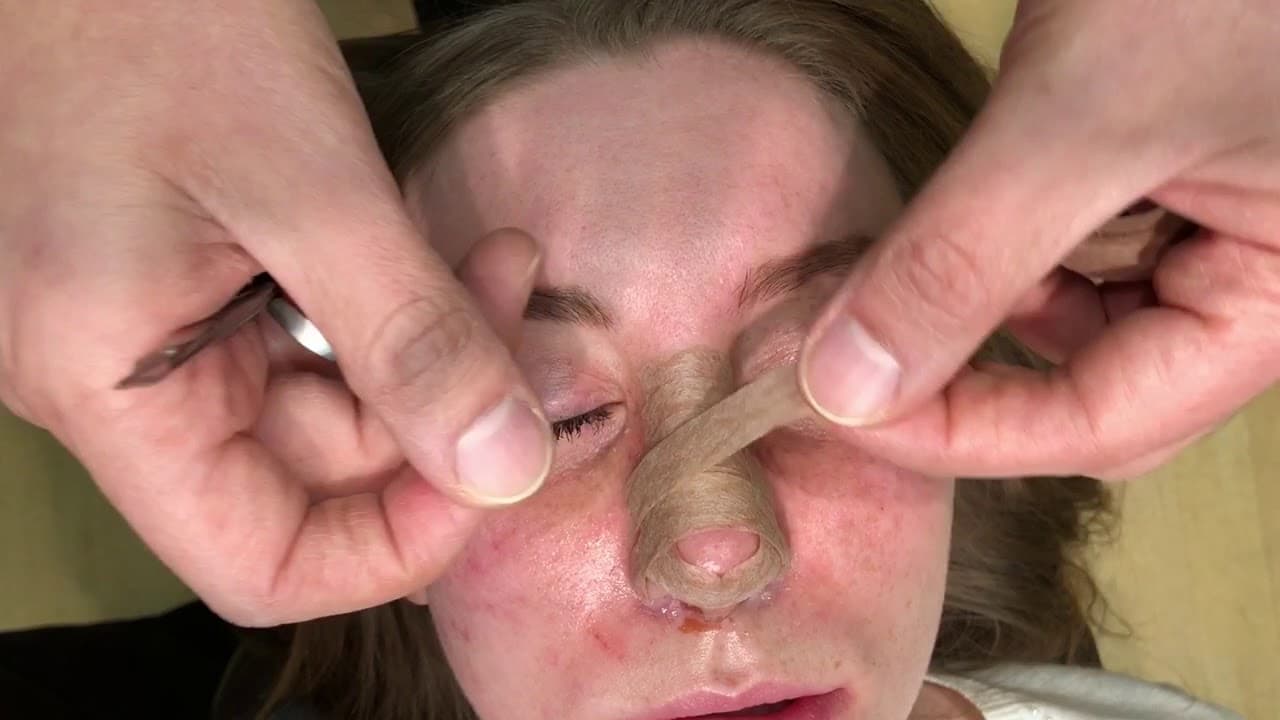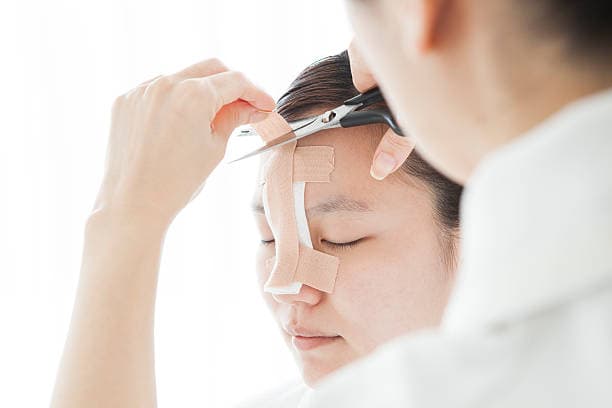Nose taping is a common practice following rhinoplasty (nose job) surgery. It involves applying adhesive tape to the nose to support the healing process and help achieve the desired shape. This technique is typically recommended by surgeons to reduce swelling, minimize scar tissue formation, and ensure that the nasal structures settle into their new positions correctly.
Nose Taping After Rhinoplasty
Nose taping after rhinoplasty is a crucial step in the post-operative care process. It involves applying medical-grade adhesive tape to the nose to support the healing tissues and help maintain the new shape of the nose. This practice helps reduce swelling by compressing the nasal tissues, minimizes the formation of scar tissue, and ensures that the nasal structures settle into their intended positions. Typically, the surgeon will demonstrate the correct taping technique before the patient leaves the clinic. The tape is usually applied across the bridge and sides of the nose and is changed regularly to maintain hygiene and effectiveness. The duration of nose taping varies depending on the individual’s healing process and the surgeon’s recommendations, ranging from a few days to several weeks. Overall, nose taping is an essential part of achieving optimal results after rhinoplasty.

What are the benefits of nose taping after rhinoplasty?
Nose taping after rhinoplasty offers several significant benefits that contribute to the overall success of the surgery and the patient’s recovery. One of the primary advantages is the reduction of post-operative swelling. By applying gentle pressure to the nasal tissues, the tape helps to compress the area, which can significantly minimize swelling and expedite the healing process. This is particularly important in the initial weeks following surgery when swelling is most pronounced. Additionally, nose taping aids in maintaining the new shape of the nose. After rhinoplasty, the nasal structures are delicate and can be prone to shifting. The tape provides a supportive framework that helps to stabilize these structures, ensuring that they settle into their intended positions. This support is crucial for achieving the desired aesthetic outcome and preventing any unwanted changes in the shape of the nose.
Another benefit of nose taping is the prevention of scar tissue formation. By keeping the skin and underlying tissues in place, the tape minimizes movement and friction, which can reduce the risk of excessive scar tissue development. This is particularly beneficial for patients who are prone to keloid or hypertrophic scarring. Furthermore, nose taping can enhance the overall comfort of the patient during the recovery period. The tape provides a sense of security and stability, which can alleviate anxiety and discomfort associated with the healing process. It also serves as a reminder to the patient to avoid touching or bumping their nose, which can be crucial for preventing accidental damage.
The process of nose taping is relatively simple and can be easily incorporated into the patient’s daily routine. Surgeons typically demonstrate the correct taping technique before the patient leaves the clinic, ensuring that they feel confident in applying and changing the tape as needed. The tape is usually changed every few days to maintain hygiene and effectiveness. The duration of nose taping varies depending on the individual’s healing process and the surgeon’s recommendations, but it generally ranges from a few days to several weeks. Overall, nose taping is an essential component of post-rhinoplasty care that offers numerous benefits, including reduced swelling, shape maintenance, scar prevention, and enhanced comfort, all of which contribute to optimal surgical outcomes.

How to Tape Your Nose after Rhinoplasty
Taping your nose after rhinoplasty is an essential part of the post-operative care process, and it involves several careful steps to ensure optimal healing and results. First, it is crucial to start with a clean and dry nose. Gently cleanse the area with a mild, non-irritating cleanser and pat it dry with a soft towel. This helps to remove any oils or residues that could affect the adhesion of the tape. Next, you will need medical-grade adhesive tape, which is typically provided by your surgeon or can be purchased at a pharmacy. Begin by cutting the tape into strips of appropriate length, usually about 2-3 inches long. The first strip should be placed horizontally across the bridge of the nose, just below the nasal bones. This provides initial support and helps to anchor the subsequent strips.
Continue by applying additional strips of tape diagonally across the sides of the nose, starting from the bridge and moving towards the tip. Each strip should overlap slightly with the previous one to ensure even pressure and coverage. Be sure to apply the tape gently but firmly, avoiding excessive tightness that could cause discomfort or impede circulation. The goal is to provide gentle compression to the nasal tissues without causing pain or irritation. Once the sides of the nose are taped, you can add a final strip horizontally across the tip of the nose to secure the previous strips in place.
It is important to change the tape regularly, typically every 2-3 days, to maintain hygiene and effectiveness. When removing the tape, do so slowly and carefully to avoid pulling on the skin or causing any damage. If you experience any redness, irritation, or discomfort, consult your surgeon for advice on alternative taping techniques or materials. Additionally, follow any specific instructions provided by your surgeon, as individual cases may vary.
Throughout the taping process, it is essential to be gentle and patient. The tape serves as a supportive structure that aids in reducing swelling, maintaining the new shape of the nose, and preventing scar tissue formation. By following these steps and adhering to your surgeon’s recommendations, you can help ensure a smooth and successful recovery after rhinoplasty. Remember, the key to effective nose taping is consistency and care, so take your time and be diligent in your post-operative routine.

How long should I tape my nose after rhinoplasty?
After undergoing rhinoplasty, the duration for which you should tape your nose can vary based on individual healing progress and your surgeon's specific recommendations. Generally, taping is an essential part of the post-operative care routine, aimed at reducing swelling and helping the skin conform to the new nasal structure. Most surgeons recommend taping the nose for at least 1-2 months post-surgery. This period can extend up to 3 months in some cases, depending on the patient's skin type and the extent of the surgery.
The primary purpose of taping is to minimize swelling and support the healing process. Taping helps the skin to shrink wrap down onto the underlying bone and cartilage, ensuring a smoother and more defined final result. It also provides a psychological benefit, as it serves as a visual reminder to others to handle the nose delicately during the recovery period.
During the initial weeks following rhinoplasty, taping is typically done continuously, with the tape being changed every few days as per the surgeon's instructions. As the healing progresses, the frequency of taping may be reduced. Some surgeons might advise patients to tape their nose only at night during the later stages of recovery to maintain the desired shape and reduce any residual swelling.
The type of tape used is also crucial. Surgeons usually recommend hypoallergenic surgical tapes that are gentle on the skin yet provide adequate support. These tapes are typically 0.5 inches in width and are designed to adhere well without causing irritation. It's important to follow the specific taping technique demonstrated by your surgeon to ensure optimal results. Incorrect taping can lead to uneven pressure distribution, which might affect the healing process.
Patients should also be mindful of their overall post-operative care routine. This includes avoiding strenuous activities, keeping the head elevated while sleeping, and following a healthy diet to promote healing. Regular follow-up visits with the surgeon are essential to monitor progress and make any necessary adjustments to the taping regimen.

Final results following nose taping
The final results following nose taping after rhinoplasty are a culmination of meticulous surgical technique and diligent post-operative care. Taping plays a crucial role in shaping the nose during the healing process, and its effects become more apparent as the swelling subsides and the tissues settle into their new configuration.
Initially, taping helps to reduce swelling and support the nasal structure, ensuring that the skin adheres closely to the underlying framework of bone and cartilage. This is particularly important in the first few weeks’ post-surgery when the tissues are most malleable. By providing gentle, consistent pressure, taping aids in minimizing edema and promoting a smoother contour. Patients often notice a significant reduction in swelling within the first month, although some residual swelling can persist for several months.
As the healing progresses, the benefits of taping become more evident. The skin begins to shrink wrap around the new nasal structure, leading to a more defined and refined appearance. This process can take several months, and the final results are typically visible around 6 to 12 months post-surgery. The nose gradually adopts its final shape, with improved symmetry and proportion that align with the patient's aesthetic goals.
The type of tape used and the technique of application are critical factors in achieving optimal results. Hypoallergenic surgical tapes are commonly recommended to avoid skin irritation. The tape should be applied in a manner that provides uniform pressure without causing discomfort. Surgeons often demonstrate the correct taping technique to ensure patients can continue the practice at home effectively.
In addition to taping, other aspects of post-operative care contribute to the final outcome. Maintaining an elevated head position while sleeping, avoiding strenuous activities, and following a healthy diet all support the healing process. Regular follow-up visits with the surgeon allow for monitoring progress and making any necessary adjustments to the care regimen.
The psychological aspect of taping should not be overlooked. It serves as a constant reminder to handle the nose gently, reducing the risk of accidental trauma during the vulnerable healing phase. Moreover, seeing the gradual improvement in nasal shape can be encouraging for patients, reinforcing their commitment to the post-operative care routine.

Conclusion
In conclusion, nose taping after rhinoplasty is a vital component of the post-operative care regimen that significantly influences the final aesthetic outcome. By reducing swelling, supporting the nasal structure, and helping the skin conform to the new shape, taping ensures a smoother and more refined result. Adhering to your surgeon's instructions on taping technique and duration, along with maintaining overall post-operative care, is essential for achieving the best possible results. Patience and consistency in following these guidelines will ultimately lead to a successful and satisfying recovery, revealing the full benefits of your rhinoplasty procedure.
Read More